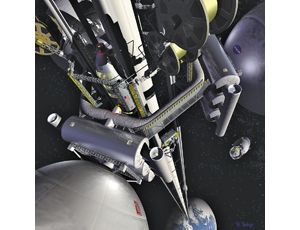
The Space Elevator's most critical component, it's cable stretching between earth and space, awaits further advances in nanotechnology.
The first thing to understand about space elevators is that, in principle, they should work.
“A space elevator appears feasible, with the realization that risks must be mitigated through technological progress,” concludes the International Academy of Astronautics in a peer reviewed feasibility assessment with 41 contributors published late last year. “A space elevator infrastructure will be achievable through a major global enterprise,” the report states.
 |
The concept is that a lightweight, high-tensile-strength ribbon anchored to the earth at the equator would be held taunt and aloft by centrifugal force if it was long enough and a significant mass was attached to the end. The rotation of the earth would keep the weight tugging the end of the cable with enough force that payload carriers could climb it like a pole and become progressively lighter as they escaped Earth’s gravity and approached the point of geostationary orbit, 26,000 miles out. People and materials could ascend regularly and smoothly to GSO and beyond at a fraction of the cost and violence of rocket launches from the surface today.
The IAA, and other engineering and scientific groups studying the concept, say that, technologically, the only barrier that stands in the way of constructing one on Earth is lack of a material light and strong enough for the ribbon, although there is optimism that nano technology may hold the key to producing exactly that, and soon. Scientists say that an elevator could be built on the moon now with available materials, given the moon’s much lower gravity and consequent demand on the cable.
The dream is glimmering.
Scientists say that a space elevator could be built on the moon now with available materials, given the moon’s much lower gravity and consequent lower demand on the cable.
On Sept. 24, a research team at Penn State University announced that it has discovered how to produce ultra-thin diamond nanothreads by putting benzine under extreme, slowly-released pressure. The thread promises to be stronger and harder than any other material in the world.
“The threads we formed have a structure that has never been seen before," John Badding, the research team leader, said in the discovery announcement. The core is a long, thin strand of carbon atoms arranged just like the fundamental unit of a diamond's structure — zig-zag “cyclohexane” rings of six carbon atoms bound together, in which each carbon is surrounded by others in the strong triangular-pyramid shape of a tetrahedron, the announcement stated.
"It is as if an incredible jeweler has strung together the smallest possible diamonds into a long miniature necklace," said Badding. "Because this thread is diamond at heart, we expect that it will prove to be extraordinarily stiff, extraordinarily strong, and extraordinarily useful."
"One of our wildest dreams for the nanomaterials we are developing is that they could be used to make the super-strong, lightweight cables that would make possible the construction of a "space elevator" which so far has existed only as a science-fiction idea," added Badding in the announcement.



Post a comment to this article
Report Abusive Comment